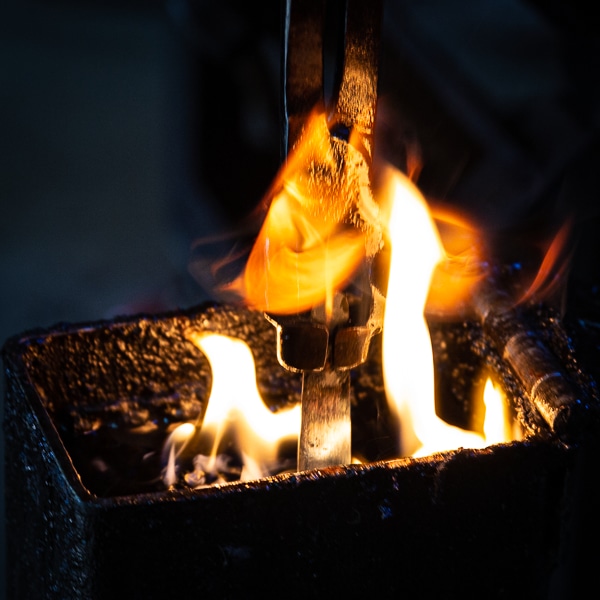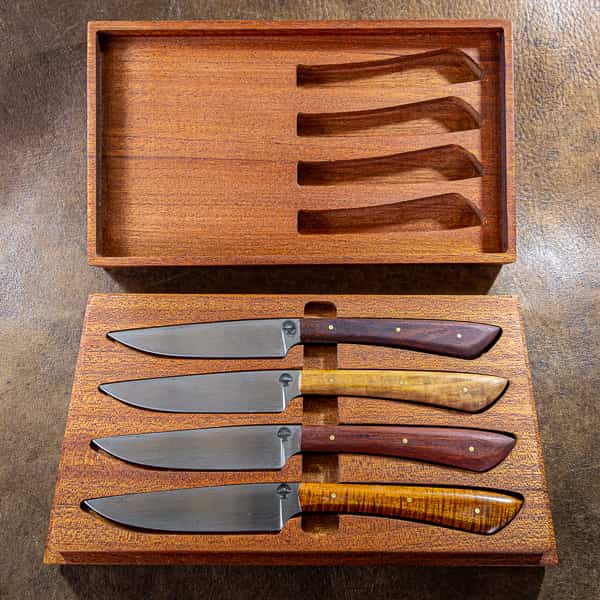If you get off on the right foot, you can start making knives and make it a hobby that pays for itself. At first you will be subsidising your knifemaking with a bit more money here and there, but after a short while your knifemaking will probably be paying for itself.
The trick is to view any money you spend as an investment. Everything you spend on training, equipment, services and raw materials is an investment that you’re aiming to see a return on. Most importantly, you’re going to enjoy doing it.
The very first thing you need to do is figure out your initial budget for tools, training, materials and services, and put it in a separate bank account. This is your knife making fund - when you invest in equipment and materials the money comes from here, when you sell knives money goes back in here.
By way of example, a budget of $2000 can get you well on the way. This budget gets you started using stock removal, but with the skills to progress to forging and heat treating at home with the addition of a forge and anvil (or anvil shaped object).
Here’s how that $2,000 budget might look:
- $750 Equipment
- $250 Materials
- $150 Services
- $850 Training
Equipment
Take a look at our equipment guide - depending on buying new or used it will cost you between $500 and $1000 to get setup. You won’t be able to heat treat at home, but that’s where having a budget for heat treating services comes in.
Materials
The materials you first start with depend on the first knives you make (more on that in a moment). At the very least, this is going to include knifemaking steel, handle material, fasteners, and workshop consumables like glue and abrasives. It might also include sheath materials like leather and Kydex, along with the associated sheath hardware.

Services
If you don’t have a forge, you’re going to need a budget for heat treatment. This can cost from $10-$25 per blade and usually has a turn-around of 2-4 weeks. On the upside, having someone else take care of heat treatment means you can work with steels that might otherwise be impractical for a beginner to heat treat.
Other services may include laser marking, surface finishes like Cerakote, and hand engraving. It’ll be tempting to try everything to start with, but it’s best to have a few runs on the board first so you know how much value these services would add to the price of your work.
Training
Remember, all of this spending is an investment that will be repaid over time. The better the skills base you’re starting from, the quicker and more likely this investment is repaid.
If you’re serious about learning something, then you know you’re going to be making a lot of mistakes. Learning from your mistakes, on your own, runs the risk of reinforcing bad habits that will eventually become roadblocks to success. If you start-off with the right knowledge you cut the risk down substantially.
Training also saves you money on equipment purchases. By having a go on equipment that you could otherwise not afford, you’ll get a sense of what you really need as opposed to what you want. You’ll also have the chance to ask questions of an expert instructor and get some advice that’s suited to what you’re trying to do.
It’s worth keeping in mind that training comes in many forms.
Yes, investing in formal training when you’re starting out is important, but it also it sets you up to access training and development that isn’t accessible to the public. Two of the most immediate things are getting to a standard where you’re ready to join a Guild so you can access the knowledge of their expert members, and secondly, developing the confidence you need to enter competitions that will give you valuable feedback from Masters and help get your name out there.
Designing your first knives
Don’t go crazy and start with Carbon Fibre or Mammoth Tooth or other exotic materials. Stick to the basics and keep it easy to start with - this goes for blade geometry as much as it does the materials used. It’s hard to make mistakes the right way and learn from them when you’ve got too many confounding factors going on.
Every knifemaker, including all of us here at Tharwa Valley Forge, have tried to reinvent the wheel when they were a beginner. You’re going to have some grand design that will change the world, you’re going to make it using crazy materials, and it’s going to come out horrible. Everyone does it and we’re under no illusions that discouraging you is going to prevent it.
So when you’re staring at your completed Titanium and Damasteel Kukri-Gyuto Folding Outdoor Kitchen Survival Knife and feeling a combination of shame and disappointment, remember that every knifemaker has felt what you’re feeling at that point.

What's profitable for a beginner to make?
There are a million ways you could do this, but steak knives are a great place to get started. You can forge them or make them using stock removal. They don’t need much material for blade or handles, and if you forge them you can even make them without using handle material.
A set of six steak knives costs about $40 in steel and consumables to make, yet will sell for ten times that.
They are a simple, small blade that doesn’t require a tonne of hand sanding, making them easy to turn out at a high standard that will command a good price. Making them in sets of four to six may sound repetitive, but it will quickly progress important skills in grinding and surface finishing that you need locked-down before it’s worth advancing to other designs.
Since the market is swamped with cheap serrated knives, handmade steak knives with a simple sharp edge are easy to differentiate as a product with superior performance and distinct provenance. Combined with a simple handmade pouch, knife roll or box they can sell for $300 to $1400 a set. Conveniently, they are unarguably culinary knives and not weapons, making them straightforward to sell via social media.
Selling your first knives
This leads us to our final tip - who do you sell your first knives to? For most makers, this is usually family and friends. Once the friends of those people have seen those knives, they’ll come asking and away you go. Keep in mind - this isn’t going to make you rich, it’s simply a hobby that pays for itself.
Make sure your expectations are realistic and be prepared for a lot of hard work. You’re going to quickly realise that successful knifemaking is 20% making the knife and 80% selling the knife. If you can manage that, then it’s going to be a hobby that delivers 100% enjoyment.